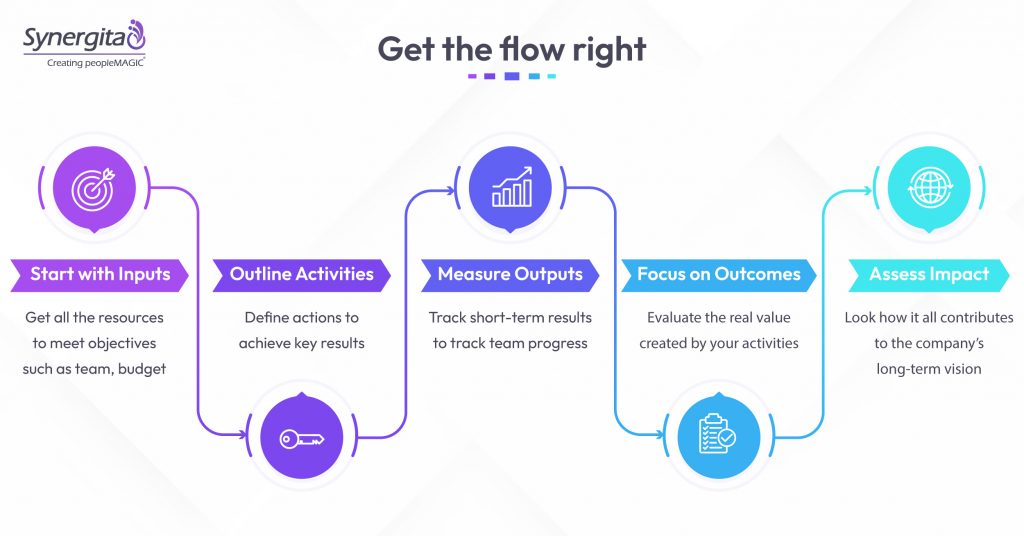The success of any organization—whether a fast-growing startup or a global enterprise—hinges on setting the right goals and aligning them with measurable outcomes. The OKR (Objectives and Key Results) framework is increasingly becoming the go-to method for forward-thinking businesses to drive focus, alignment, and results. But many C-suite executives and HR leaders struggle with the nuances of defining OKRs effectively.
This blog breaks down the fundamental components—Inputs, Activities, Outputs, Outcomes, and Impact—and explores how understanding these elements can elevate your OKR management. If you’re looking for an actionable OKR guide that resonates at every level of your organization, keep reading.
OKRs offer a simple yet powerful approach to strategic goal setting. At their core, they link high-level objectives with measurable key results. However, fully mastering OKRs requires a deeper understanding of the different phases that lead to tangible business impact. These phases include Inputs, Activities, Outputs, Outcomes, and Impact—each playing a crucial role in defining OKR goals. Let’s dive into each of these elements.

1. Inputs: Laying the Groundwork
Before diving into OKR creation, consider your inputs. These are the resources, tools, and raw materials that form the foundation of your objectives. For example, an HR team looking to increase employee engagement needs to evaluate key inputs such as employee feedback surveys, HR software, and leadership training programs.
Tip for OKR Management: To define meaningful OKRs, take stock of your inputs and ensure that they match the long-term objectives of your business. Misaligned inputs can lead to misdirected activities and outputs.
2. Activities: Driving Effort Toward the Goal
Activities are the steps you take to move towards your desired outcomes. These are the efforts directly tied to your objectives. Think of activities as the tangible work your teams perform daily. For instance, if your objective is to boost sales by 20%, the activities could include sales team training, customer outreach initiatives, or launching new marketing campaigns.
OKR Tip: It’s crucial to distinguish between activities and outcomes. While activities are necessary for progress, they alone don’t define success. Success hinges on measurable outputs and outcomes.
3. Outputs: The Immediate Results
Outputs are often the most visible markers of progress but don’t always indicate long-term success. In sales, outputs might include the number of customer meetings held, the new leads generated, or the percentage of customer inquiries converted to sales. These outputs reflect short-term progress but don’t necessarily show the full impact.
4. Outcomes: The True Measure of Success
Outcomes are the real business impacts of your activities. Outcomes reflect whether your OKRs have achieved their intended purpose. For instance, if your goal was to increase employee engagement (a typical HR objective), the outcome could be an increase in employee retention and productivity. Outcomes are often long-term and directly affect your company’s strategic direction.
Insight: To define OKR goals that truly matter, focus less on outputs and more on outcomes. How will your initiatives add value to your business?
5. Impact: The Lasting Legacy
Finally, impact refers to the long-term change your business achieves because of your outcomes. Impact is typically aligned with your broader mission and vision. For example, if your objective was to become a market leader, achieving significant revenue growth or expanding market share would represent a lasting impact. Impact shows the cumulative effect of all your activities, outputs, and outcomes over time.
Tip for Defining OKR Impact: When defining impact within your OKR framework, think about the big picture. How will achieving this OKR contribute to your company’s long-term vision? Ensure that your impact is quantifiable and aligns with your strategic goals.
Concept in Action in the Real-World
Let’s discuss these concepts in a real-world scenario to address a problem of declining customer satisfaction in a retail chain
Inputs
- Hiring additional staff to reduce the workload during peak hours.
- Training to improve customer service skills.
- Upgrading POS systems to make checkouts faster and more efficient.
Activities
- Implement new staffing schedules and hire 20% more customer service associates.
- Conduct customer service training for all floor employees.
- Install upgraded POS systems across stores and test them for speed and accuracy.
Outputs
- Reduced checkout wait times by 30%.
- More staff to assist customers, leading to quicker resolutions of customer queries.
- A new return process that reduces customer complaints about slow returns.
- Outputs are measurable, but they represent the short-term effects of the activities.
Outcomes
- Customer satisfaction scores improve from 65% to 85% within the next quarter.
- Repeat customer visits increase by 20% with better in-store experience.
- Employee feedback shows that job satisfaction has improved due to clearer roles and smoother operations.
Impact
- Retail chain earns a name for superior customer service.
- Profit margins increase as higher customer satisfaction translates to more sales, customer loyalty, and reduced churn.
- Company maintains its reputation, leading to a greater market share.
Making OKRs Work for Your Business
The beauty of OKRs lies in their versatility and scalability. Whether you’re in the C-suite, managing HR, or leading a business unit, you can tailor the OKR framework to suit your needs by understanding the nuances of inputs, activities, outputs, outcomes, and impact. By shifting your focus from outputs to outcomes and ultimately to long-term impact, you ensure that your OKRs are not just boxes to tick off but strategic tools that drive meaningful growth. Start defining OKRs that lead to real results. Use this guide to transform your organization’s approach to goal setting and watch how quickly you surpass your business targets.

